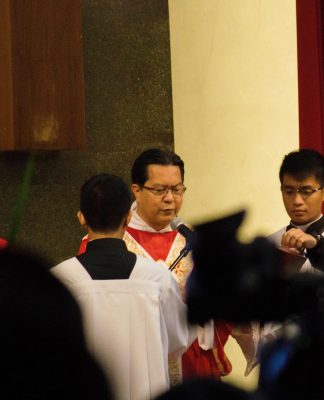 THIS is how you do it in May 2010.
THIS is how you do it in May 2010.
The Commission on Elections (Comelec) and Smartmatic – the company tasked to automate next year’s polls – gave the Thomasian community a taste of how the first computerized national elections would take place.
Some 500 students saw a demonstration of the voting procedure using a precinct count optical scan (PCOS) machine at the UST Seminary Gym last September 25.
Comelec spokesman James Jimenez likened the computerized voting system to texting, “since the machine produces the election returns only in a minute.”
The PCOS is attached to a big ballot box, which has two compartments for “valid” and “invalid” ballots.
The ballot can be accomplished by shading small oval icons beside candidates’ names, using a marker provided by the Comelec.
Comelec is buying 80,000 PCOS machines for the polls under the P11.2-billion automation project.
Jimenez said this would lessen confusion among election inspectors, who “sometimes resort to guessing” because of poor penmanship of the voters.
However, he warned voters that there would be no second chances in case they commit mistakes in filling up ballots.
“That is what you call responsibility. Every voter should protect his vote,” Jimenez said.
Comelec officials sought to address fears of massive election failure should the machines fail to deliver.
In an open forum with the students, Jimenez admitted that the machine could be hacked, “but the hacker will have a hard time.”
“Just imagine how many numerical combinations the hacker should enter before he can open a machine. And if one machine is hacked, it won’t destroy the whole system,” he said.
Jimenez added that the machine’s content could be verified any time questions are raised.
He expressed optimism that automation would lessen vote-padding and vote-shaving or dagdag-bawas, and other tools of election fraud.
But for Rector Fr. Rolando de la Rosa, O.P., voters should be “more intelligent” in choosing the country’s next leaders.
“The more stupid the leaders were, the more stupid are the constituents,” De la Rosa said in his speech during the launching of the “Boto Tomasino” campaign the day before.
The three-hour launch last September 24 was highlighted by the film of Sally Jo Bellosillo titled Laban ng Edsa that looked back at events from the Martial Law era to the restoration of democracy following the 1986 People Power revolt that installed Corazon Aquino
The event was also graced by one of Aquino’s daughters, Pinky Aquino-Abellada.
It was in UST where Comelec, the National Citizens Movement for Free Elections, and the Parish Pastoral Council for Responsible Voting launched their voter awareness and registration campaign in December of last year.
Jimenez, a UST alumnus, said UST has been instrumental in its campaign to educate the youth about the elections.
“UST is one of the schools we have always been to because of its very strong voters’ education advocacy,” Jimenez said.















